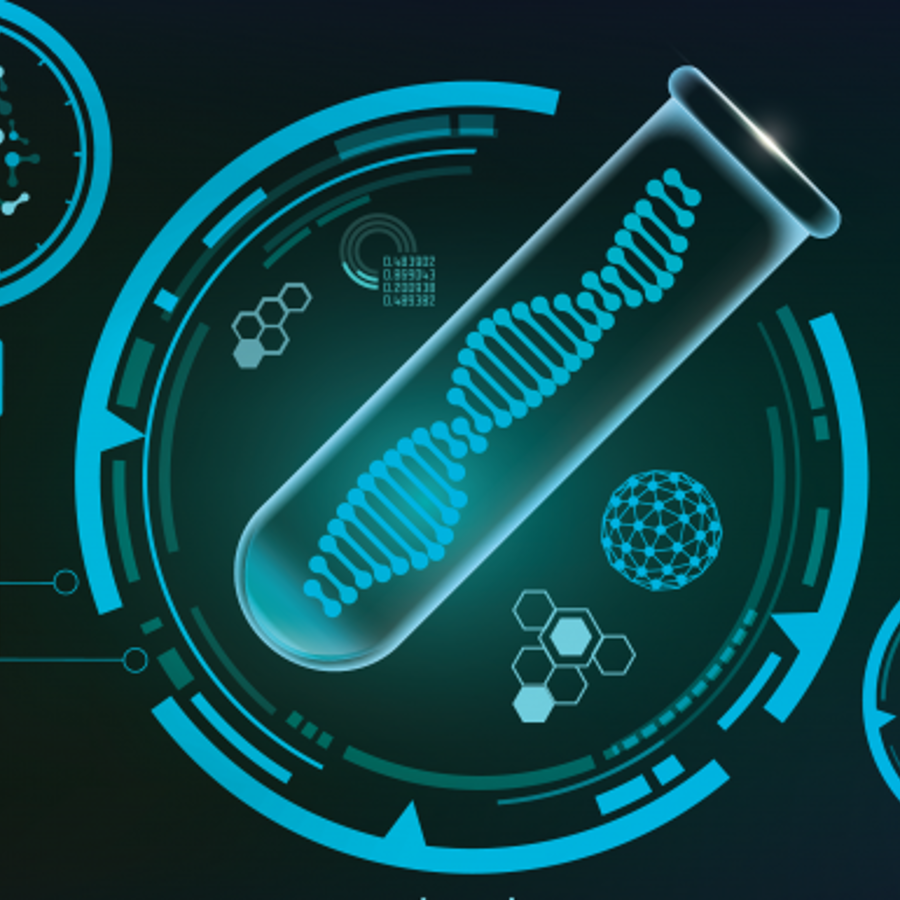
Can my cousin and I be tested to see if my father was really my father?
May 3, 2012

- Related Topics:
- Consumer genetic testing,
- Genetic genealogy,
- Genetic testing,
- Chromosomes,
- Paternity tests,
- Relatedness
A curious adult from California asks:
"Can my cousin and I be tested to see if my father was really my father? Her mother and my father were brother and sister."
Yes, a DNA test could tell you that. But a typical paternity test won’t usually be able to help you unless you test a lot more relatives than just you and your cousin.
The exceptions are if your two related parents were brothers and you both were male or if the two related parents were female. But neither of these fits your situation.
In your case, you’ll need to use a newer test like the kind that 23andMe offers*. The difference between the two tests is how much DNA they look at.
A paternity test compares only 15 or 20 small bits of DNA while the newer tests compare millions. This difference means that you can see things with the newer test that you just can’t with the old school ones.
And you need one of these high-powered tests because first cousins only share around 12% of their DNA. Looking at just a little bit of DNA just isn’t enough to tell if two people are cousins. No, for most cases involving just first cousins, you need to compare the two DNAs at lots of different places.
To understand why we need to look at millions of bits of DNA, we need to take a step back and think about what happens when DNA is passed on. And why that makes seeing relationships so complicated.
*In addition to relatedness, these newer tests can also tell you a bit about yourself. For the most part though, this information is not yet as solid as the relatedness but I thought you should be aware of what else comes with this particular test.

Passing DNA
You get half of your DNA from your mom and half from your dad. And since your parents got their DNA from their parents, you also have some DNA from your grandparents.
You and a first cousin share a set of grandparents so you also share some of their DNA. That’s why you have about 12% of the exact same DNA. Here is what your family tree looks like all diagrammed out:
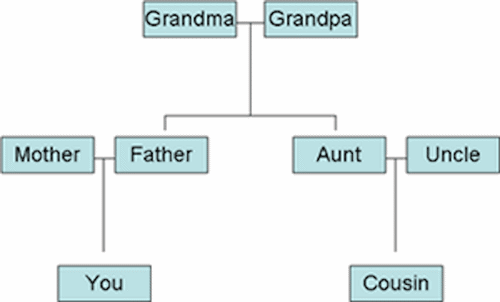
This diagram shows how the two of you are related. What I want to do next is show what is happening at the DNA level.
Before doing that though, we need to remember four things about our DNA:
- Our DNA is found in long strands called chromosomes.
- Humans have 23 pairs of chromosomes.
- One of each pair comes from mom and the other one from dad.
- We pass down just one of each pair.
OK, now we’re ready to look at a diagram of what is going on when DNA is passed down. I have drawn out what things might look like if the two of you are really first cousins:
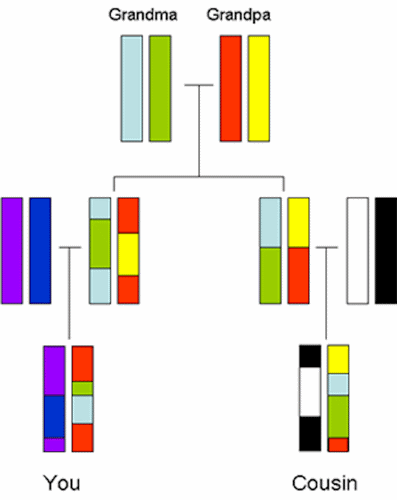
A little explanation is in order. First off, I am only focusing on one pair of chromosomes. Remember this same thing is happening with the other 22 pairs.
Second, notice that the chromosome that gets passed down is actually a mix of the two in the original pair. This is why your dad doesn’t have an all green or an all blue from grandma. Instead he got one chromosome that had pieces from each. (Same thing with grandpa.)
I don’t have time to go over this here, but this process is called recombination. And as you can see it happens in every generation.
It’s kind of like you have two different really long books and you copy a couple of chapters from one and a few from the other and paste them together to make a new book. Only in this case you end up with a chromosome!
Comparing First Cousin DNA
Now let’s just focus on you and your cousin’s DNA:
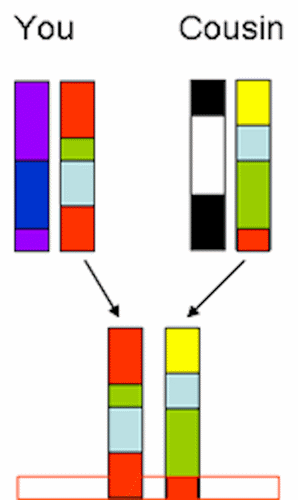
Here we just want to look at the chromosomes that have shared DNA. This is why we are ignoring what your mother gave you (the purple and blue chromosome) and your uncle gave your cousin (the black and white one).
You can see that each chromosome is a mix of your grandparents’ DNA. But the only shared part happens in the red part right at the bottom. If you were to look at these chromosomes without seeing the grandparents’ DNA, this would be the only part that would say they were related.
Here is what might happen with a standard paternity test:
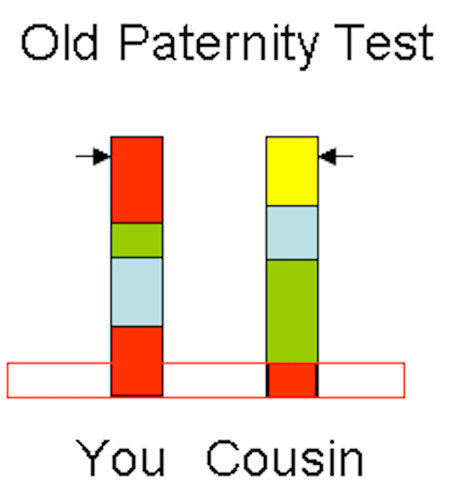
The black arrow shows the DNA spot the testing company looks at on this chromosome. As you can see, you and this person do not happen to share this particular bit of DNA. So this would not tell you that you were related.
Here is what happens with one of the newer tests:
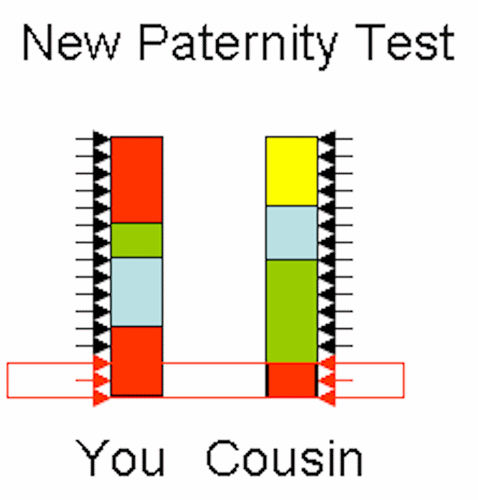
Now because they look at so many more spots, you can see the DNA you and your cousin have in common (the red arrows). What is even more important in telling that the two of you are related is that the red arrows are all in a row.
See, any two people have a lot of DNA in common. After all, DNA has the instructions for making us, and all humans share a lot in common. Which means they share a lot of DNA in common too.
What this means is that any two people are going to share a lot of spots here and there throughout their DNA. Here is what the test results would actually look like:
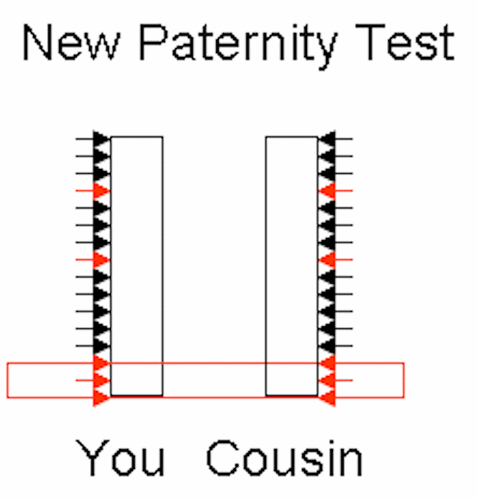
The upper red arrows are DNA the two of you happen to share in common. They are there because you both are human, not because you are closely related.
Remember before I said your chromosome’s kind of like a long book that has chapters from different parents? That big red chunk of DNA that you and your cousin both have is like a whole chapter of the book that’s exactly the same. It’s the same because you both happened to get it from your grandpa.
The other matching arrows are more like having single words that are the same. Two long books are bound to have the word “the” or “and” at the exact same place between the two books. The isolated arrows are more like these single words.
When we see those three hits in a row, we can start to assume that all the DNA between those hits is also the same. It’s like we’re looking at a few paragraphs from the two chapters, seeing that those paragraphs are the same and then realizing that the whole chapter must be the same.
After all, if you were looking at two books and noticed that they each had a chapter with the same sentences, you’d probably think the writers got the chapter from the same place. You wouldn’t think that they just happened to write the same thing.
So when the test compares your DNA to your cousin’s, it looks for spots that are the same all in a row and realizes that those chunks of DNA are probably the same. Then they figure out how many chunks of your DNA are exactly the same all over your 23 pairs of chromosomes.
From that they can figure out that the two of you share about 12% of your DNA. Lots of different relations can share that much DNA though.
That is why the family history is important too. From that you can tell that the two of you are first cousins.

Author: Elizabeth Tanner
When this answer was published in 2012, Elizabeth was a Ph.D. candidate in the Department of Genetics, studying preventing drug-resistance in viruses in Karla Kirkegaard's laboratory. She wrote this answer while participating in the Stanford at The Tech program.
 Skip Navigation
Skip Navigation
